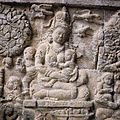Mendut
Appearance
| Mendut | |
|---|---|
| Native name Javanese: ꦩꦼꦤ꧀ꦢꦸꦠ꧀ | |
 | |
| Location | Magelang, Central Java |
| Coordinates | 7°36′20″S 110°13′44″E / 7.6055°S 110.229°E |
| Built | Originally built in the 9th century during the reign of the Sailendra Dynasty |
| Restored | 1925 |
| Restored by | Theodoor van Erp |
| Architect | Gunadharma |
| Type | Cultural |
| Criteria | i, ii, vi |
| Designated | 1991 (15th session) |
| Part of | Borobudur Temple Compounds |
| Reference no. | 592 |
| State Party | |
| Region | Southeast Asia |
Mendut (Indonesian: Candi Mendut) is a Buddhist temple built in the 9th century during Sailendra dynasty. It is 2.9 km east of Borobudur temple in Magelang, Central Java. Based on Karangtengah inscription (dated 824 AD), Mendut temple was created and finished during King Indra's reign. Candi Mendut, Candi Pawon and Candi Borobudur form a straight line geographically, which symbolizes the binding unity of Buddhist temples during its ritual ceremonies.[1]
Gallery
[change | change source]-
Geographic location of Borobudur-Pawon-Mendut to form one straight line.
-
Three statues of Dhyani Buddha Vairocana, Avalokitesvara, and Vajrapani inside the Mendut temple.
-
Hariti, the bas-relief on inner wall of Candi Mendut.
Related pages
[change | change source]References
[change | change source]- ↑ J. L. Moens (1951). "Barabudur, Mendut en Pawon en hun onderlinge samenhang (Barabudur, Mendut and Pawon and their mutual relationship)" (PDF). Tijdschrift voor de Indische Taai-, Land- en Volkenkunde. Het Bataviaasch Genootschap van Kunsten en Wetenschappen: 326–386. Archived from the original (PDF) on August 10, 2007. Retrieved March 9, 2022.
trans. by Mark Long





